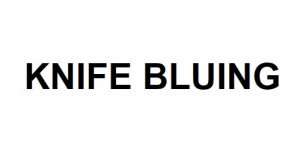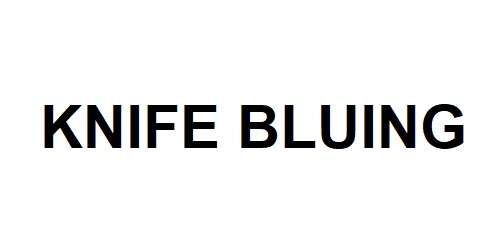Knife Bluing is a process of giving a proper chemical finish to the knife’s blade so it becomes resistant to corrosion. This process is done in factories during the manufacturing of knives. But if you want to try it at home, it is doable too. In this article, we will talk about knife bluing and also tell you the ways by which you can do this procedure at home.
Types Of Knife Bluing:
Mainly, there are two types of knife bluing.
- Hot Bluing
- Cold Bluing
Let’s talk about them in detail.
Hot Bluing:
In hot bluing, you need to apply different heating methods on the knife before soaking it in a heated stainless steel tank. This tank consists of salts that are used to preserve a knife’s blade.
Following we have listed some pros and cons of hot bluing. Take a look at them:
Pros Of Hot Bluing:
- Hot bluing is the professional and best way to blue a knife.
- Best chemicals are used for hot bluing and that’s why the knife last longer than the knife without hot bluing.
Cons Of Hot Bluing:
- Hot bluing is an expensive procedure.
- It takes a lot of time to hot blue a knife.
Cold Bluing:
Cold Bluing is a simple and easy technique to blue a knife. All you need is some materials that are easily available in your home and a knife-bluing paste or solution. Cold Bluing solution is easily available in the market and you can get them from any knife shop. This solution is also available in international online markets.
Pros Of Cold Bluing:
- Cold Bluing doesn’t take much time.
- Cold Bluing is economical and you can do it by yourself at home.
Cons Of Cold Bluing:
- The effects of cold bluing are only for some days and then you have to blue the knife all over again.
- You need to be extra cautious while cold bluing the knife.
How To Do Knife Bluing At Home?
Knife Bluing is a simple procedure but it is advised that you do not do hot bluing of the knife at home. Hot bluing is best for commercial knife bluing. So if you want to try the bluing at home, we recommend that you do the cold bluing. It is a quick process and is done with just a few materials mostly available in your home.
These materials include:
- Knife Sharpener
- Heat Source( Stove or Propane Torch)
- Clean cloth(Microfiber)
- Crayon
- Naval Jelly
- Degreaser
- Steel Wool Mesh
- Knife Bluing Solution
Procedure Of Knife Bluing
Let’s see how you can blue the knife at home using the materials for cold bluing:
1- Sharpen The Blade:
First of all, you have to sharpen the blade of the knife using a blade sharpener. Sharpen the knife thoroughly and get rid of every type of blurring. Sharpening the knife will help in removing any type of bumpy areas on the knife.
2- Apply The Degreaser:
During the bluing process, no amount of grease or oil must be present on the blade. Do avoid the grease, apply a degreaser on the blade and clean it so that no amount of oil is left behind. Make sure to clean the knife with a clean cloth before moving to the next step.
3- Use Naval Jelly:
Pick a naval jelly and apply it to the blade. Make sure to leave no spot and then let the naval jelly sit in for an hour. Naval Jelly is used to remove rust from steel. If you do not have the jelly, you can use vinegar too.
4- Rub Steel Wool Mesh:
An hour after applying the naval jelly, take a steel wool mesh and rub it everywhere on the blade. You need to scuff the surface of the blade with it. A steel wool mesh will smoothen the blade and clean it of any impurities.
5- Heat The Blade:
You need to heat the blade on a stove or with a propane torch. The heating technique depends on the material of the handle. If the handle of the knife is metal, heat it at 325°F for 10 to 15 minutes on the stove or oven. If the handle is wood or plastic, heat it with a propane torch for only 2 to 3 minutes.
6- Use The Crayon To Draw The Edge:
Mark the area you want to blue. Use a crayon to mark the area to be blued. Mostly, the bluing is done on the edges of knives. Mark the edges before marking anything else.
7- Apply The Bluing Solution:
Now take out the knife bluing solution and put it on the microfiber cloth. Rub the solution from the tip to the bottom of the blade multiple times. Add a second coat if needed when the first coat has dried.
Tips While Bluing The Knife
There are some things that you should know before knife bluing. Take a look at them for the easier procedure:
- You must blue the knife in an area where proper ventilation is available.
- You should use all the safety and caution tips while bluing the knife.
- Knife-bluing chemicals are extremely toxic so make sure you do not swallow them accidentally.
Advantages Of Knife Bluing:
Knife bluing has several benefits and some of which are given below:
- Knife bluing is the best way to keep your knife away from rust and corrosion.
- By bluing your knife, you extend the life span of the knife and preserve the blade to last longer.
- It is best for carbon steel blades because
Disadvantages Of Knife Bluing:
- You can get scratches on your knife during the process of bluing it.
- Knife bluing seems like an extra expenditure because, for some people, knife-bluing solutions can be costly.
Final Words:
Sometimes it is important to blue a knife to expand its life so it can work for a long time. Knife bluing is an easy procedure and you should do it to your knife so it doesn’t rust or get scratched. In this article, we have explained the way to do knife bluing along with its types. Now the decision is all yours if you want to blue your knife or not.

